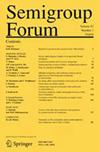坎纳潘函数方程在半群上的扩展
IF 0.7
3区 数学
Q2 MATHEMATICS
引用次数: 0
摘要
设 S 是半群,Z(S) 是 S 的中心。在本文中,我们确定了 Kannappan-d'Alembert 函数方程 $$\begin{aligned}\displaystyle \int _{S} f(xyt)d\mu (t) +\displaystyle \int _{S} f(\sigma (y)xt)d\mu (t)= 2f(y)f(x),\x,y\in S. 的复值解、\end{aligned}$$and Kannappan-Wilson's functional equation $$begin{aligned}\displaystyle \int _{S} f(xyt)d\mu (t) +\displaystyle \int _{S} f(\sigma (y)xt)d\mu (t)= 2f(y)g(x),\x、yin S,\end{aligned}$$其中 \(\mu \)是一个度量,它是狄拉克度量的线性组合 \((\delta _{z_i})_{i\in I}\), such that \(z_i\in Z(S)\) for all \(i\in I\), and\(\sigma :)对于第一个等式来说是一个渐开自变或渐开反自变,对于第二个等式来说是一个渐开自变。我们还给出了一些有趣的应用。本文章由计算机程序翻译,如有差异,请以英文原文为准。
An extension of Kannappan’s functional equation on semigroups
Let S be a semigroup, Z(S) the center of S. In this paper, we determine the complex-valued solutions of Kannappan–d’Alembert’s functional equation
$$\begin{aligned}\displaystyle \int _{S} f(xyt)d\mu (t) +\displaystyle \int _{S} f(\sigma (y)xt)d\mu (t)= 2f(y)f(x),\ x,y\in S,\end{aligned}$$and Kannappan–Wilson’s functional equation
$$\begin{aligned}\displaystyle \int _{S} f(xyt)d\mu (t) +\displaystyle \int _{S} f(\sigma (y)xt)d\mu (t)= 2f(y)g(x),\ x,y\in S,\end{aligned}$$where \(\mu \) is a measure that is a linear combination of Dirac measures \((\delta _{z_i})_{i\in I}\), such that \(z_i\in Z(S)\) for all \(i\in I\), and \(\sigma :S\rightarrow S\) is an involutive automorphism or an involutive anti-automorphism for the first equation and an involutive automorphism for the second one. We also give some interesting applications.
求助全文
通过发布文献求助,成功后即可免费获取论文全文。
去求助
来源期刊

Semigroup Forum
数学-数学
CiteScore
1.50
自引率
14.30%
发文量
79
审稿时长
12 months
期刊介绍:
Semigroup Forum is a platform for speedy and efficient transmission of information on current research in semigroup theory.
Scope: Algebraic semigroups, topological semigroups, partially ordered semigroups, semigroups of measures and harmonic analysis on semigroups, numerical semigroups, transformation semigroups, semigroups of operators, and applications of semigroup theory to other disciplines such as ring theory, category theory, automata, logic, etc.
Languages: English (preferred), French, German, Russian.
Survey Articles: Expository, such as a symposium lecture. Of any length. May include original work, but should present the nonspecialist with a reasonably elementary and self-contained account of the fundamental parts of the subject.
Research Articles: Will be subject to the usual refereeing procedure.
Research Announcements: Description, limited to eight pages, of new results, mostly without proofs, of full length papers appearing elsewhere. The announcement must be accompanied by a copy of the unabridged version.
Short Notes: (Maximum 4 pages) Worthy of the readers'' attention, such as new proofs, significant generalizations of known facts, comments on unsolved problems, historical remarks, etc.
Research Problems: Unsolved research problems.
Announcements: Of conferences, seminars, and symposia on Semigroup Theory.
Abstracts and Bibliographical Items: Abstracts in English, limited to one page, of completed work are solicited.
Listings of books, papers, and lecture notes previously published elsewhere and, above all, of new papers for which preprints are available are solicited from all authors.
Abstracts for Reviewing Journals: Authors are invited to provide with their manuscript informally a one-page abstract of their contribution with key words and phrases and with subject matter classification. This material will be forwarded to Zentralblatt für Mathematik.
 求助内容:
求助内容: 应助结果提醒方式:
应助结果提醒方式:


